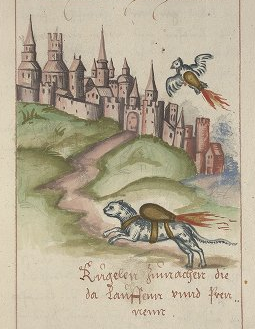‘Rocket Cats’ In The 16th Century? Illustrations Show Animals Strapped To ‘Jet Of Fire’ [PHOTO]

It looks like 16th century soldiers had quite the imagination.
An illustration created by a German military engineer around 1530 shows jet packs strapped to the back of cats and doves. The drawings, which were made inside an artillery manual, were accompanied with the caption advising military commanders to "set fire to a castle or city which you can't get at otherwise."
"I really didn't know what to make of it," Mitch Fraas, a historian and digital humanities expert at the University of Pennsylvania library, told the Associated Press. "It clearly looks like there's some sort of jet of fire coming out of a device strapped to these animals."
The illustrations were part of the university’s digital collection before an Australian book blog reported on it and Fraas made it his mission to solve the mystery behind the unusual illustrations that seem to foreshadow 20th century scince fiction.
Artillery master Franz Helm of Cologne drew the illustrations. He is believed to have fought in multiple battles against the Turks just as gunpowder was being introduced into warfare. The “rocket cat” in question, Fraas deduced, may have been a strategy Helm came up with to attack the enemy.
That is, catch a cat from enemy territory, strap a bomb to it and make it run back home to wreak havoc. Helm didn’t mince his words. According to Fraas’ translation of Helm’s caption, he wrote:
"Create a small sack like a fire-arrow. If you would like to get at a town or castle, seek to obtain a cat from that place. And bind the sack to the back of the cat, ignite it, let it glow well and thereafter let the cat go, so it runs to the nearest castle or town, and out of fear it thinks to hide itself where it ends up in barn; hay or straw it will be ignited."
While there’s no proof that Helm took his own advice, Fraas says this idea of animal-delivered pyrotechnic warfare has popped up in historical texts from disparate regions throughout the world.
“Though not actually depicting ‘rockets’ of any kind, these images help demonstrate the enormous demand for manuals on gunnery and explosives in the early modern period as well as the robust world of 16th c. manuscript copying and the persistence of illustrations and manuscript forms into print,” Fraas wrote on his blog.
© Copyright IBTimes 2024. All rights reserved.






















